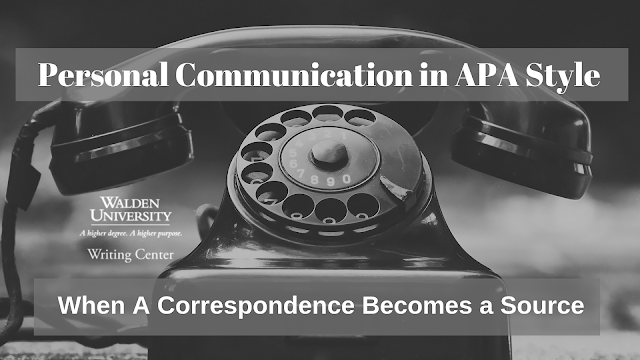Personal Communications in APA Style: When a Correspondence Becomes a Source
One source of information for evidence-based scholarly writing that gets somewhat overlooked is the personal communication. Though journal articles, academic books, and credible web pages are the most frequent sources used in academic writing, asking an authority in your field about a topic can certainly produce credible and useful evidence. Like other sources, though, APA requires that you document personal communications in a specific way. Identifying, citing, and referencing these sources correctly, while recognizing their limitations, gives authors a new well of information an evidence to help them support their ideas.

Identifying Personal Communications
Before you can work with personal communications, you first need to identify what sources fall under that category. According to section 6.20 of the Publication Manual of the American Psychological Association, personal communications include “private letters, memos, some electronic communications, personal interviews, telephone conversations, and the like” (p. 179). Obviously, there is a bit of ambiguity here. One defining factor of personal communications is that they “do not provide recoverable data” (p. 179). There is not published document that is associated with these sources. This is one stark difference that separates personal communications from other sources.
Personal Communications and Reference Lists
Another distinguishing feature that is specific to personal communications is that they are not included in a reference list (Section 6.20). I know, this feels really weird. But, because there isn’t any published record of this source, there’s essentially nowhere to direct the reader for access to these sources. This too sounds weird. I assure you, though, these are acceptable sources.
Citing Personal Communications
Lastly, when you cite personal communications, you include three pieces of information: the author’s name (including the author’s first initial), the words “personal communication,” and the exact date of communication (Section 6.20). This citation looks different than other citations that you may be more comfortable with. In a typical citation, you should include the last name of the author and the year of publication. In a personal communication, you show the reader in the very citation that this is a personal communication.
Personal Communication Citation Examples:
Narrative citation: M. Dusek (personal communication, August 30, 2018) argued that …
Parenthetical citation: (M. Dusek, personal communication, August 30, 2018).
Limitations of Personal Communications
Personal communications do have their limitations. As with all sources, you don’t want to lean to heavily on one particular source or type of sources to support your point. You want to include a strong variety of sources. This shows the reader that you’ve consulted a variety of perspectives on your topic. Similarly, because there isn’t a published, accessible record of personal communications, they should be used sparingly. This means that they aren’t verifiable by the reader, so these shouldn’t be the backbone of any argument that you are making. Lastly, the credibility of a personal communication is only as good as the person who is saying something. If the person you have corresponded with is of questionable credibility, your authority will similarly be questioned by the reader. To combat this, you can offer something of the person’s credentials as you introduce them to the reader.
For example: “M. Dusek (personal communication, August 30, 2018), Writing Instructor at Walden University, argued…”
Conclusion
Admittedly, personal communications aren’t the most common source used in academic writing. Still, for those of you participating in a long and detailed research process, this may be something that can be useful to you. As with all sources, citing these correctly can build your authority with the reader. It is also important to recognize that these sources have limitations and are meant to be used sparingly. Still, if you are wanting to use personal communications in your work, it is acceptable to do so.
Michael Dusek is a writing instructor in the Walden University Writing Center. He enjoys working with students and improving their writing skills. The idea that an essay is expressive as well as formal is a cornerstone of the way he views writing. He believes that approaching a writing project as a creative problem-solving activity can alleviate apprehension that students often encounter. In his personal life, he enjoys the outdoors, books, music, and all other types of art.
.png)
Never miss a new post; Opt-out at any time
Subscribe to:
Post Comments
(
Atom
)




No comments :
Post a Comment